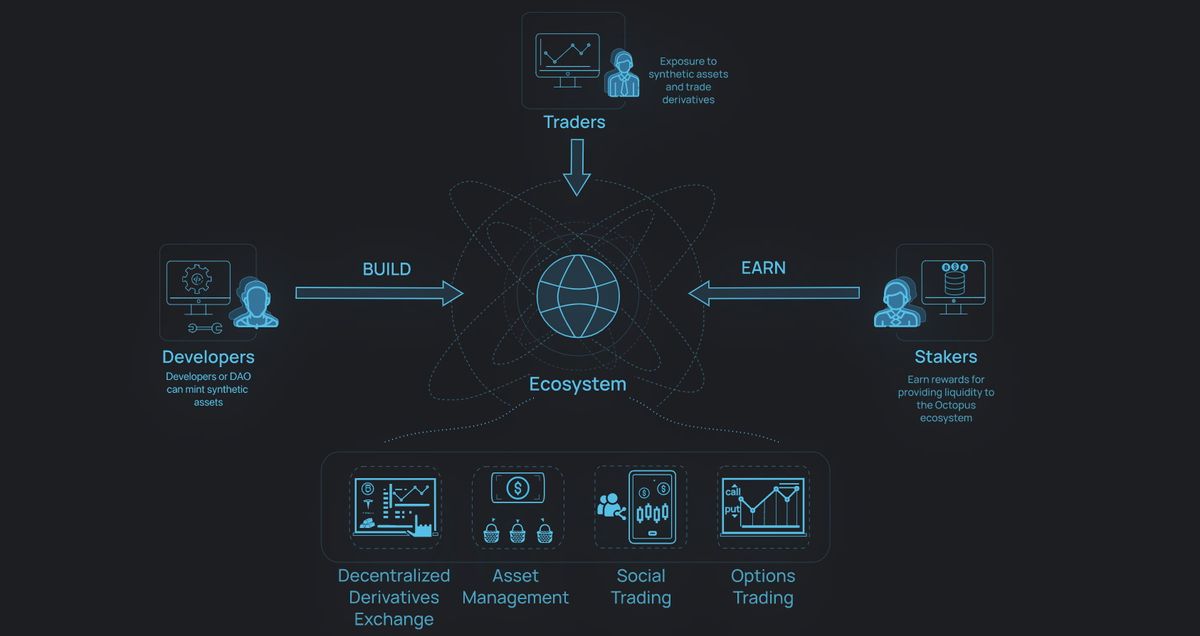Octopus Protocol unleashes the untapped potential of the DeFi derivatives market

While 2020 was a rather interesting year for the entire cryptocurrency sector, 2021 appears to be maintaining momentum. From the influx of institutional investment to sustained interest in decentralized finance (DeFi) and the growing popularity of non-fungible tokens (NFTs), the overall cryptocurrency is poised to have another impressive year.
This year’s DeFi rally cannot be mentioned without highlighting the unprecedented growth of the decentralized derivatives market. Data shows that between April 2020 and May 2021, the total market cap of the DeFi sector rose from $3 billion to a peak value of $142 billion. As of press time, the total market cap of the sector was $91 billion. Similarly, the total value locked (TVL) across DeFi protocols has also risen from $675 million to over $48 billion within the same period. Decentralized derivatives, a subset of the DeFi industry, witnessed a sharp growth, with its TVL climbing from $132 million to $2.6 billion between 2020 and 2021. That being said, it is obvious that the decentralized derivatives market is growing at an accelerated pace and will likely witness a surge in both interest and investments in 2021.
Octopus Protocol is positioning itself to harness the untapped potential of the decentralized derivatives market. The Binance Smart Chain (BSC)-based DeFi protocol boasts of a plethora of products that enable the issuance, trade, and management of decentralized derivative assets. Furthermore, the protocol combines the best features of a prominent blockchain network, facilitating an affordable market solution for the decentralized derivatives market.
Unmatched exposure to real-world assets
As earlier stated, Octopus Protocol combines a multitude of products under its ecosystem – from trade derivatives to asset management, social trading, and options trading. Its solution facilitates complete engagement with tokenized derivatives (synthetic assets) from a single platform. Users can gain unlimited exposure to many instruments from multiple derivatives assets, including stocks, equities, bonds, digital assets, and futures. Its trade derivatives also boast of tight spreads, zero liquidation risks, and low margin requirements.
While the traditional derivative market relies on centralized infrastructures that introduce several bottlenecks such as unequal opportunities, geographical barriers, preferential accessibility, and high transaction costs, Octopus Protocol utilizes advanced technological solutions to eliminate the unfair market dynamics and circumvent the market barriers.
Octopus Protocol allows users to create or mine tokenized derivatives that grant access to several real-world underlying assets. And by deploying an open protocol for creating, exchanging, settling, and managing synthetic assets, Octopus Protocol is fuelling limitless possibilities from the untapped potential of the derivatives market.
OPS, a native token to drive change
At the center of the Octopus ecosystem is a native utility token, OPS. OPS will be used as a tool to incentivize and reward users who engage with the Octopus Protocol. It also doubles as a pivotal element to capture the value of different products of the ecosystem, particularly the decentralized derivatives exchange, social trading, decentralized asset management, and options trading.
A third function of the OPS token will be its governance properties. The token will grant voting rights to holders, thereby enabling community governance within the protocol.
As per its tokenomics, OPS is based on the BEP-20 standard and has a maximum total supply of 150,000,000. The initial circulating supply is 8,700,000.
Conclusion
Considering the immense potential of the decentralized derivatives market and the solution of Octopus Protocol, one could conclude that the project is uniquely positioned to become the next game-changer in the DeFi market.
According to the project’s roadmap, a testnet launch of Octopus Protocol is expected to go live in Q2 2021. Meanwhile, the mainnet launch and the testnet launch of its decentralized derivatives exchange have been scheduled for Q3 2021.
Although the project is currently using the Binance Smart Chain (BSC) to enable high throughput, lower gas fees, and relative scalability, it will be expanding to Polkadot in the future.




